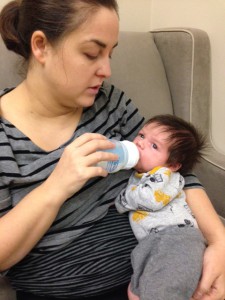 The milk that we buy at the grocery store has been pasteurized and homogenized. The pasteurization process kills all the bacteria and live cells in the milk—making it safe for us to drink, but also less stable. Homogenizing the milk blends in the fat so that it doesn’t separate and float to the top. Most of us don’t have experience using fresh milk straight from the source. Fresh milk from any mammal—including humans—looks very different from the milk we buy at the store.
The milk that we buy at the grocery store has been pasteurized and homogenized. The pasteurization process kills all the bacteria and live cells in the milk—making it safe for us to drink, but also less stable. Homogenizing the milk blends in the fat so that it doesn’t separate and float to the top. Most of us don’t have experience using fresh milk straight from the source. Fresh milk from any mammal—including humans—looks very different from the milk we buy at the store.
After your milk has been expressed and it has been sitting on the counter or in the refrigerator for a while, the fat will begin to separate. You may notice a thin layer of cream on top of milk that looks quite watery. That is perfectly normal. Your milk has not gone “bad.” Continue reading
